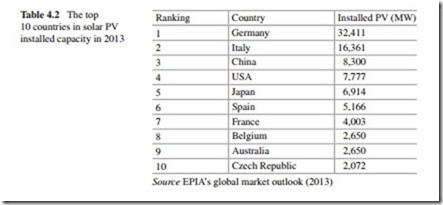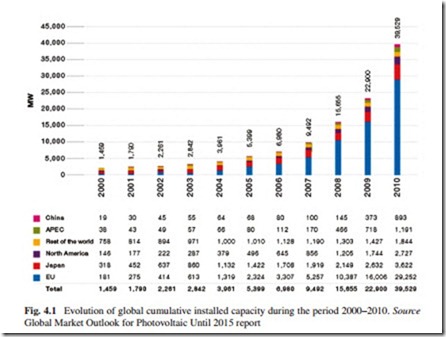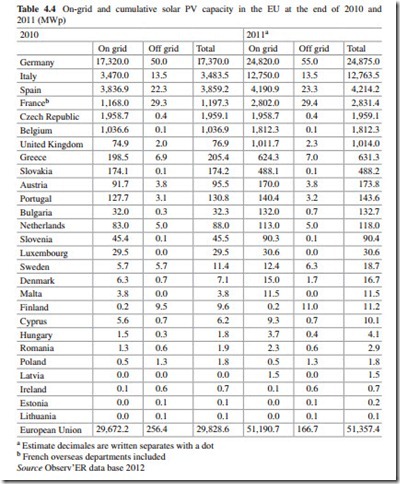Solar Photovoltaic
Solar PV is a potentially clean, reliable, and consumer-friendly renewable energy source. A solar PV is a device that converts light into electric current using the photoelectric effect. In 2012, available efficiencies in solar PV exceed 20 %. The cost of producing solar PV electricity has fallen dramatically over the past decades, but it is still only competitive in niche (usually remote) stand-alone appli- cations. Such systems generally involve storage systems and hybrid systems with one or more auxiliary power generators to ensure continuity of supply. Large (<1 MW) projects have also been undertaken with all electricity supplied to the grid through an inverter. For solar PV plants, the load factors vary from 10 to 25 %. At the highest load factor, the levelized costs of solar-generated electricity are reaching between US$215 per MWh and US$333 per MWh. With the low load factors, the levelized costs of solar-generated electricity are around US$600 per MWh.
Worldwide solar PV sales reached 6 GW in 2010 with an important portion for decentralized power generation; one US survey estimates the market for solar PV equipment in 2012 to be US$27.5 billion. In the EU-15, it is estimated that signifi- cant market potential exists, perhaps as high as 2,000 MW, compared with 52 MW in 1995 and around 200 MW in 1999. During 2002, installed solar PV capacity in the EU grew some 37 % to 392 MW. Primary research continues to reduce costs and improves efficiency and reliability. Solar PV cells with efficiencies of the order of 40 % and more are now being developed.
According to Global Market Outlook for PV until 2015 report, over the past decade, the solar PV market has experienced unprecedented growth. In particular, in the last years, the solar PV market has reached a cumulative installed capacity of roughly 40 GW worldwide, with an annual added capacity of 16.6 GW. The solar PV power is well on the way to becoming a fully competitive part of the electricity system in the EU and an increasingly important part of the energy mix around the globe.
The total installed capacity of solar PV systems in the EU at the end of 2009 was 7.2 GW, approximately 2.2 % of total electrical capacity. However, the solar PV market is still incipient. In the EU, only 0.4 % of total supplied electricity came from solar PV in 2009. Out of the 27.5 GW of total new power capacity constructed in the EU in 2009, solar PV accounted for about 21 % (5.8 GW, up from 5.1 GW in 2008). It is estimated that one GW of solar PV electricity generation capacity provides enough electricity for about 250,000 European households during one year. For 2010, the global solar PV market is estimated with a newly installed capacity of about 15.5 GW, reaching a total cumulative capacity of about 38 GW worldwide. In Europe, which has an estimated newly installed capacity of about 10 GW, most corporate research and development investments in solar PV are from companies with headquarters in Germany, France, Spain, and the UK.
The solar PV industry experienced significant growth in 2010. Capacity additions grew from 7.2 GW installed in 2009 to 16.6 GW in 2010; this means an increase of 130.5 %. In 2011, a total of 21.53 GW of solar PV capacity was installed in the EU; this represents a further increase of 29.7 % with respect to 2010. In that year, a total of 44.8 TWh of solar electricity was generated in the EU.
In 2012, more than 69 GW of solar PV were installed at the world level, pro- ducing 85 TWh of electricity in that year. This energy volume is sufficient to cover annually the supply needs of over 20 million households. However, it is important to highlight the following: The amount of new solar power installed in Europe in that year fell sharply for the first time in more than a decade. New installations fell from 21.53 GW in 2011 to 17 GW in 2012. As a result of this decrease, Europe’s share of new capacity went down from 74 to 55 % (19 % reduction) in what the solar industry said was a turning point in the global solar PV market that will have profound implications in coming years.
In terms of global cumulative installed capacity, according to the latest report of the European PV Industry Association in 2012, Europe still leads the way with more than 70 GW (i.e., about 55 % of the world’s total solar PV cumulative capacity).1 After having scored the top position in the EU in terms of new added capacity in 2011 and 2012, solar PV was in second place in the 2013 ranking, after wind. With more than 21 GW connected to the grid for solar PV and wind, these two renewable electricity sources together beat gas and all other sources of electricity.
However, and despite of this reduction, solar PV continued its growth trend in Italy becoming the top market for the year, with 9.3 GW connected, followed by Germany (7.5 GW). These two markets were followed by France (1.7 GW) and the UK (784 MW). In terms of cumulative capacity, Germany with more than 24 GW is the leading country in Europe, followed by Italy, with more than 12 GW. Solar PV is now a significant part of Europe’s electricity mix, producing 2 % of the demand in the EU and roughly 4 % of peak demand (Global Market Outlook for PV until 2015). Depending on the scenario, the contribution of solar PV to the total European electricity production could be between 4 and 10 % in 2020, if all measures adopted by the EC are implemented by all EU member states.
According to Table 4.2, six European countries are included in the top ten countries with the highest solar PV installed capacity in the world (60 % of the total). Total global operating capacity of solar PV reached in 2012 the amount of 102 GW, led by Europe, with significant additions in Asia later in the year. Driven by falling prices, solar PV is expanding to new markets, from Africa and the MENA region to Asia and to the Latin America and the Caribbean region. Due to this expansion, solar PV remains the third most important renewable energy source after hydro and wind power, in terms of global installed capacity.
Interest in community-owned and self-generation systems continued to grow in 2012, while the number and scale of large solar PV projects also increased. Cell and module manufacturers struggled as extreme competition and decreases in prices and margins spurred more industry consolidation, and several Chinese, European, and US manufacturers went out of business. Thin film’s share of global solar PV production declined further, with production down 15 % to 4.1 GW (REN 21 2013).
The evolution of the solar PV market in recent years has been heavily linked to the confidence and vision of smart policy makers in supporting the development of the solar PV technology. In only one year, the solar PV installed capacity in Europe almost doubled, and at the current pace, Europe could increase the proportion of its electricity generated from solar PV technology by 1 % every two
Global Market Outlook for Photovoltaic Until 2015 report
years.2 According to the above report, at the end of 2008, the world’s cumulative installed solar PV capacity was approaching 16–16.6 GW in 2010 and 23 GW one year later.
From Fig. 4.1, the following can be stated: In terms of global cumulative installed capacity, the EU leads the way with almost 30 GW installed as of 2010. This represents about 75 % of the world’s total cumulative solar PV installed capacity (up from 70 % in 2009 or 22 GW), an increase of 5 %.3 Japan (3.6 GW) and the USA
(2.5 GW) are some way behind, while China has already entered the top ten of the 0.46 GW, the Czech Republic with 0.41 GW, and Belgium with 0.3 GW. However, in the EU, only 0.4 % of total electricity supplied to users came from solar PV systems in 2009. Worldwide, the percentage was a mere 0.1 %.
world’s solar PV markets and should reach its first GW before the end of 2014. In 2011, the EU’s solar electricity production was 44.8 TWh, with 51.4 GW installed capacity and new installations were 21.5 GW. EU accounted for 74 % of all newly connected capacities in 2011. The solar power share in 2011 was around 3.6 % in Italy, 3.1 % in Germany, and 2.6 % in Spain. According to Observ’ER (2013), it is expected that the total solar installation reach at least 120 GW in 2020. The national strategies are equivalent to 84 GW solar capacities in 2020, which may underesti- mate the actual development taking place. For example, according to the Ministry of Environment’s Working Group on Renewable Energy Statistics, Germany connected solar capacity of 7.5 GWp in 2011, twice the 3.5 GWp target.
According to Tables 4.3 and 4.4, Italy, Germany, and France are the countries with the highest solar PV connected to the grid in 2011 and Germany, Italy, Spain, France, the Czech Republic, Belgium, and the UK are the countries with the high- est on-grid and cumulative solar PV capacity in that year. In 2012, according to the PV Barometer 208, production capacities are set to rise to 69 GW, same as the total installed capacity worldwide at the end of 2011.
Finally, it is important to highlight the following: It can reasonably be assumed that solar PV electricity will become a mainstream power source in Europe by 2020 and a major power source in 2050. According to the European Photovoltaic Industry Association (EPIA), solar PV could supply up to 12 % of the electric- ity demand in Europe by 2020, thus representing 390 GW of installed capacity and 460 TWh of electricity generation. From 2030 to 2050, EPIA has shown the high potential of solar PV in Europe. Solar PV could reach as much a 962 GW of installed capacity by 2050 in Europe. The potential of PV electricity could, how- ever, be at least 50 % higher in Europe by 2050. Available land area and buildings in “zero impact areas” (i.e., areas not in competition with food production, natural reserves, housing, industry, or other purposes) represent a potential of more than 5,000 TWh of yearly solar PV electricity production.
According to EPIA information, the following are the most important develop- ment registered in 2013:
• At least 38.4 GW of solar PV systems were installed globally in 2013, up from 30 GW in 2012. Solar PV remains, after hydro and wind power, the third most important renewable energy source in terms of global installed capacity;
• Almost 11 GW of solar PV capacity was connected to the grid in Europe in
2013, compared to 17.7 GW in 2012 and more than 22.4 GW in 2011;
• For the first time since 2003, Europe lost its leadership to Asia in terms of new installations. China was the top market in 2013 with 11.8 GW, of which 500 MW represents off-grid systems. Statistics released in May 2014 report that the country may have installed an additional 1.1 GW on top of the 11.8 GW estimated by EPIA. Since it is unsure whether these installations were con- nected to the grid EPIA did not take them into account. China was followed by Japan with 6.9 GW and the USA with 4.8 GW;
• Germany was the top European market with 3.3 GW. Several other European
markets exceeded the one GW mark: the UK (1.5 GW), Italy (1.4 GW), Romania (1.1 GW), and Greece (1.04 GW);
• Several European markets that performed well in the past went down in 2013, a consequence of political decisions to reduce solar PV incentives, Belgian installations went from 600 to 215 MW, French went from 1,115 to 613 MW, and Danish went down from 300 to around 200 MW;
• Aside from the significant decline in Germany and Italy, the size of the remaining European solar PV market was stable, with around 6 GW per year in the last three years;
• Outside Europe, several markets continued to grow at a reasonable pace: India with 1,115 MW, Korea with 442 MW, Thailand with 317 MW, Canada with 444 MW, and many others (Global Market Outlook for Photovolatics 2014– 2018 2014).




